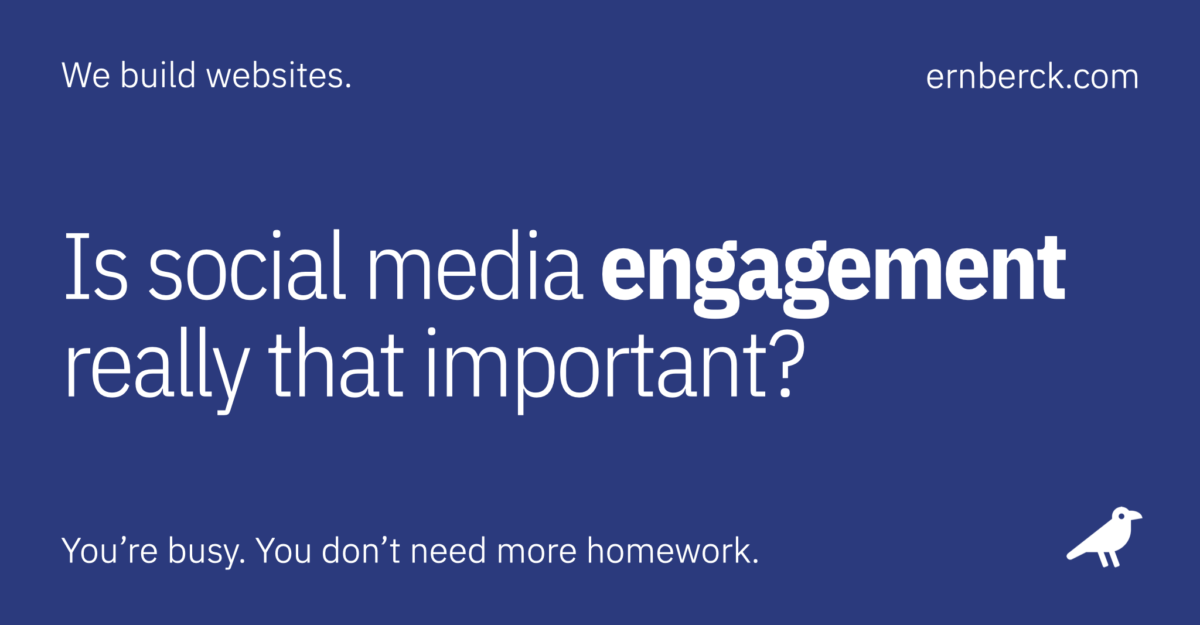Does social media engagement really matter?
From the beginning of social media (around 1997), post “engagement” has always been promoted as one of its most valuable and defining features.
Liking, commenting, following, and sharing were all types of social media interaction considered essential to a company or individual. Even today, social media “success” is typically measured by how much engagement you get.
But research suggests that this view is overly simplistic and often ignores reality. On any given platform — at any given time — the typical user is a passive information consumer. They see posts in their “feeds” or “timelines,” but don’t interact with the vast majority of them.
To be clear, I’m not suggesting that you ignore engagement. On the contrary, I just don’t think you should fret over it. Impressive engagement statistics might dazzle your boss, but it’s debatable that they do much for the bottom line.
Tip
If you’re a business owner and manage social media business accounts, it’s certainly beneficial if all of your employees regularly engage and share your content. This is often called social media advocacy.
You may have little influence over the behavior of social media followers, but employees are usually a bit more cooperative. Employee engagement will improve organic reach and help drive traffic to your main website.
A few definitions
These are a bit over-simplified, but you’ll get the idea.
Reach
Reach is simply the number of people who see your page or post, whether or not they engage with it. It is most often expressed as a percentage of your followers that see your content, but can also include non-followers.
Impressions
An impression occurs every time a person sees a particular piece of content. The number of impressions can be higher than reach because the same person might look at your content more than once. A huge number of impressions — compared to reach — can be an indication of “stickiness.”
Engagement
Engagement measures the amount of audience activity your content generates. Specifically, it refers to the number of interactions — other than just viewing — that your audience has with a piece of content.
Engagement is often expressed as a percentage of your total audience, and typically refers to the following activities:
- Likes
- Comments
- Shares
- Clicks
- Retweets (Twitter)
- Bookmarks
- Saves
Note: There are as many forms of engagement as there are social media channels, so this metric can vary widely.
Engaging on social media
The typical lifespan of a Facebook post is about six hours. Let’s break this down into some common performance measurements:
Reach: In 2012, organic (free) reach on Facebook was about 16%. Today, average reach is about 5%. After just 1 hour 50 minutes, your post will achieve 75% of its potential audience reach.
Impressions: After just 2 hours 30 minutes, your Facebook post will have made 75% of its lifetime impressions. Needless to say, if your audience never sees your post, they can’t engage with it.
Engagement: The average Facebook post engagement rate is about 0.25% (25/10,000). Over 75% of engagement happens within the first five hours. After that, it pretty much dies off.
Learn more: A Facebook page is not a website
25% of U.S. adults on Twitter generate 97% of all tweets. And although they create the vast majority of content, highly active tweeters produce relatively few original tweets, and receive little engagement from the broader Twitter audience.
Original Twitter posts comprise only 14% of tweets from the top quarter of U.S. adults. The majority of posts produced by this group were either retweets (49%) or replies to other users (33%).
Click-through rate
Click-through rate (CTR) is the percentage of people visiting a web page who click on a link to a particular advertisement.
Unless your target audience segment is in the minority of “highly active” users, don’t expect high click-through rates on organic — or even paid — content anywhere. In fact, some researchers argue that in the case of digital display ads, high CTRs are more indicative of fraud, instead of above-average engagement.
Most of LinkedIn’s 828 million users worldwide (April 2022) are passive information consumers. Recent research shows that only 4.9% of all LinkedIn users post anything. Only 18% like or comment on posts.
The number of LinkedIn posts that people pay any meaningful attention to is small. According to LinkedIn’s own algorithms, if at least 50% of a post’s content appears on screen for at least one second, it will count as an “impression.” Most of these “qualified views” have little impact on the reader at all.

Creator of the Facebook like button
“It’s very common for humans to develop things with the best of intentions, and for them to have unintended, negative consequences. One reason I think it’s particularly important for us to talk about this now is that we may be the last generation that can remember life before. Everyone is distracted now. All of the time.”
— Justin Rosenstein 2017
Lurking on social media
A landmark 2006 study indicated that 90% of social media users are lurkers who never contribute; 9% of users contribute a little, and 1% of users account for almost all the action. Recent research confirms that this pattern continues across all social media platforms today.
90%
lurker
lurk·er | ˈlərkər |
noun
A person who lurks, in particular a user of an internet message board, chat room, or social media channel who does not participate.
Lurking matters
There’s nothing wrong with being a lurker — You’re part of the vast majority of social media users. And just because someone doesn’t interact in a prescribed manner that counts as official “engagement,” doesn’t mean that they didn’t like your content.
On the contrary, some of your audience may like your content so much that they feel silly liking everything you post. I know I’m that way with a lot of people and businesses I follow. I’d feel a little odd engaging with everything they publish.
If 90% of social media users are lurkers, I’m guessing a lot of other people feel that way too. And besides, from a marketing point of view, you’re still making an impression, and that goes a long way to improving brand recognition, click-through rate, and conversions.
Brand engagement
“The vast majority of people will never like, comment, share or actively engage with a brand at all. In fact, the extent to which social media has introduced a new era of conversational, opt-in marketing — where viral content trumps traditional media spends — is greatly exaggerated.
“Social media platforms work far more like traditional media channels than we seem willing to admit as an industry. Yes, they allow for interaction, and have far more information about their viewers, but ultimately, they are valuable to marketers because they attract large audiences which we can reach highly efficiently with paid media promotion.”
— Jerry Daykin in Eat Your Greens by Wiemer Snijders (2020)
Why bother?
So, if engagement doesn’t matter, why go to the trouble and expense of posting on social media at all? Good question. Some would say don’t bother, but I think that’s a mistake.
Social media is just another form of content marketing — Using social media platforms (some pundits like to call this “omni-channel” marketing). It’s likely no better or worse than the alternatives, you just need to adjust your expectations.
Brand storytelling is another form of content marketing that has invaded social media. But it’s really just another excuse for greedy agencies to charge clueless clients even more money for results that can’t be easily measured.
Social media marketing — with or without engagement — is just the game you have to play because potential clients will look around and wonder why you didn’t show up. They’ll notice your absence more than your presence.
